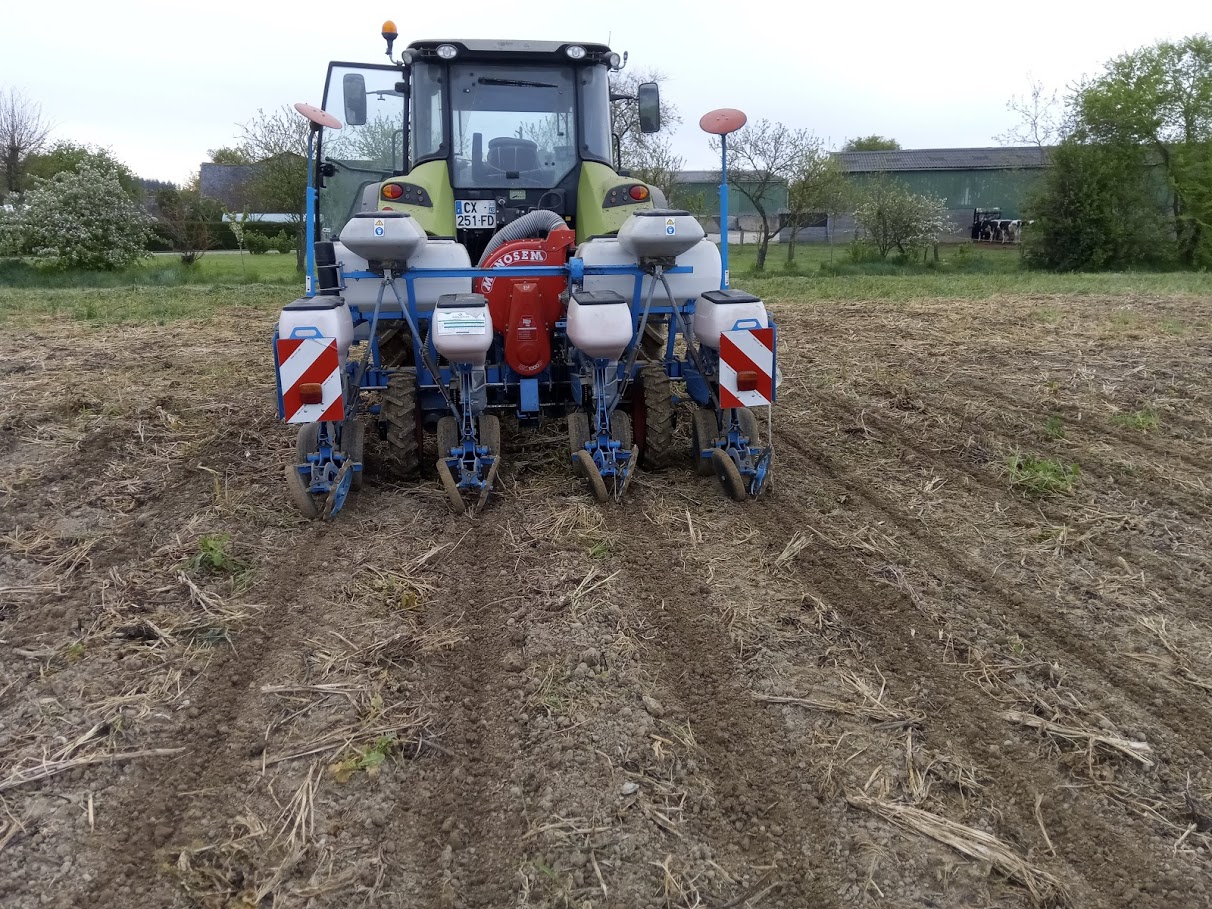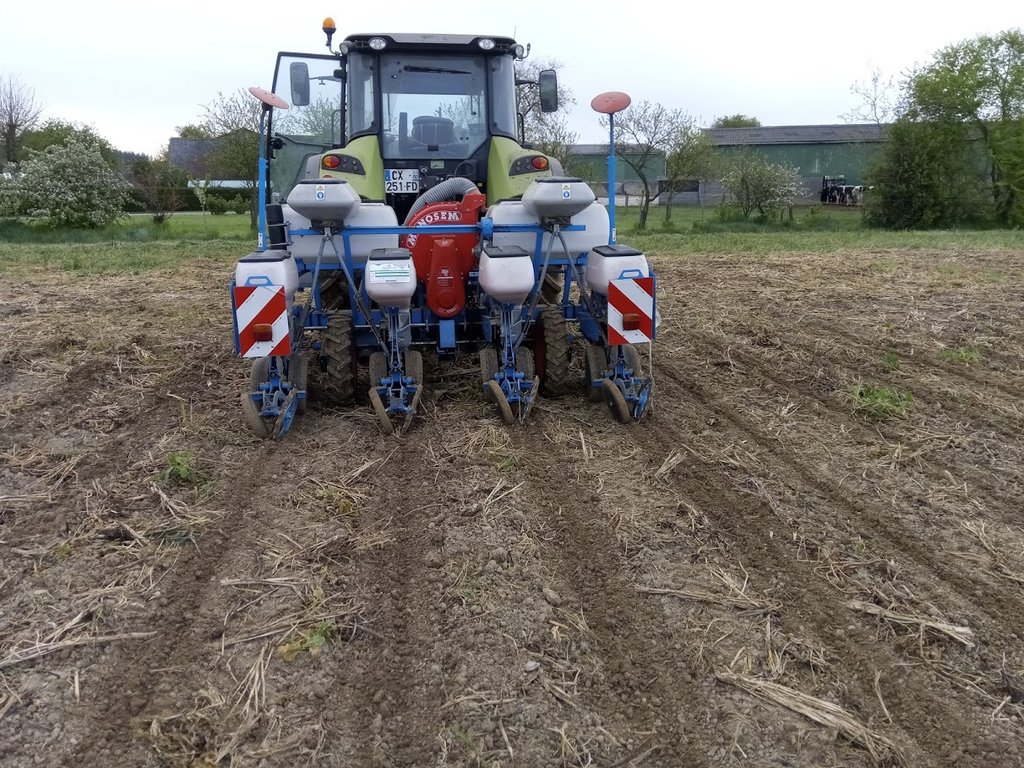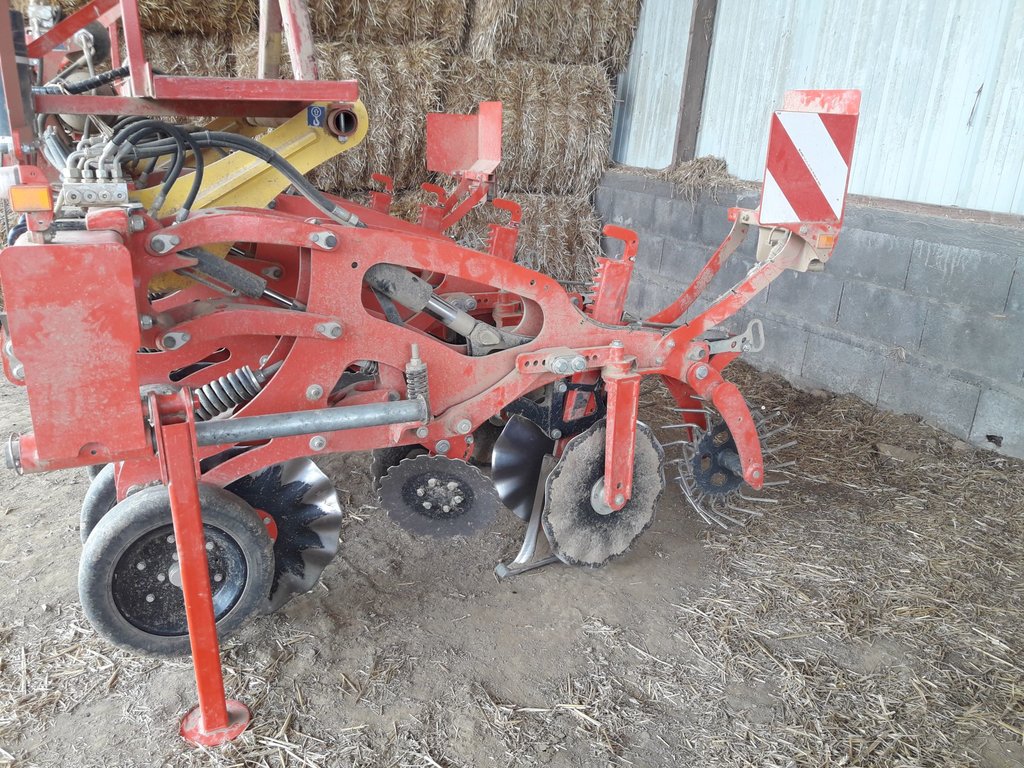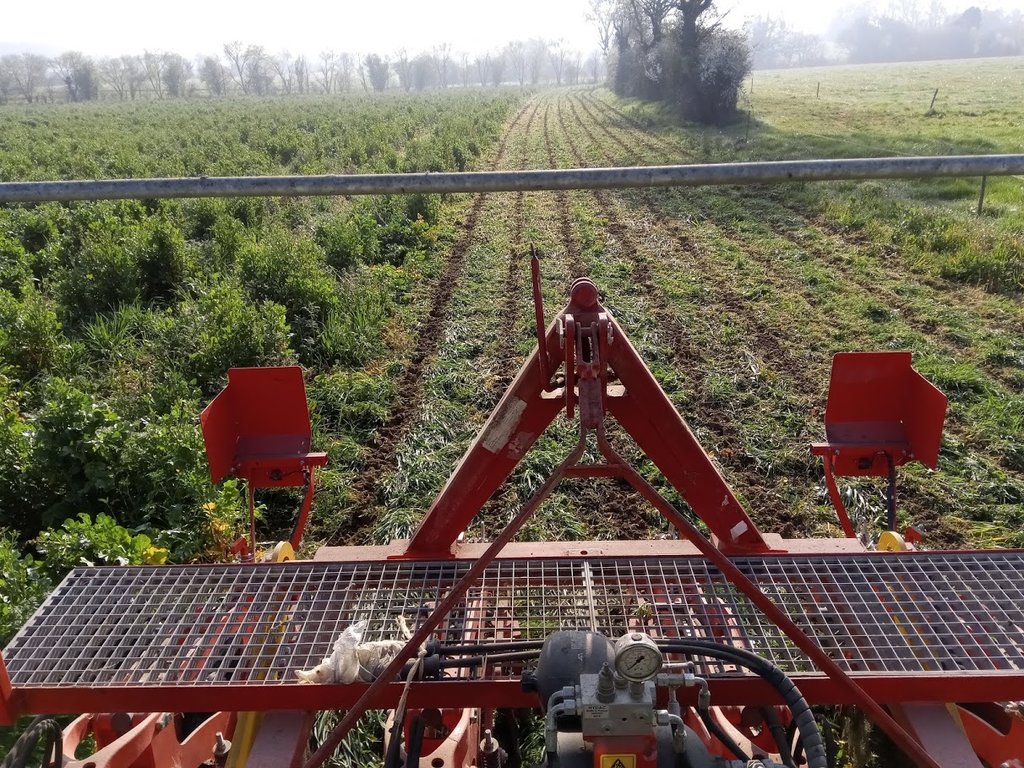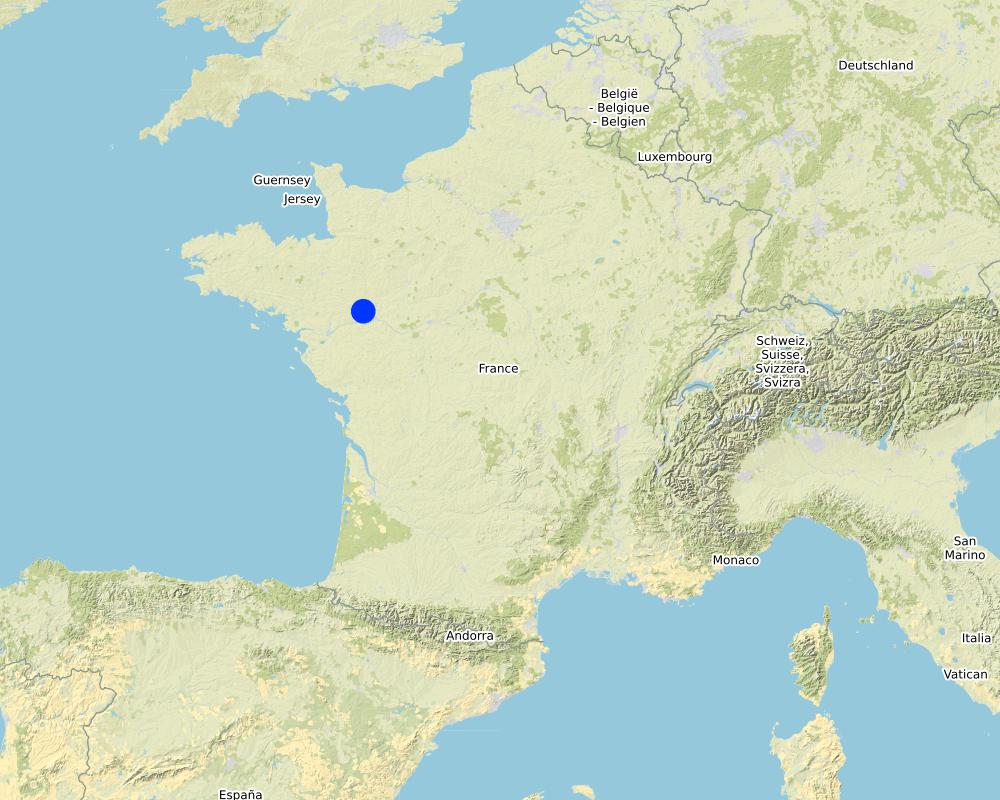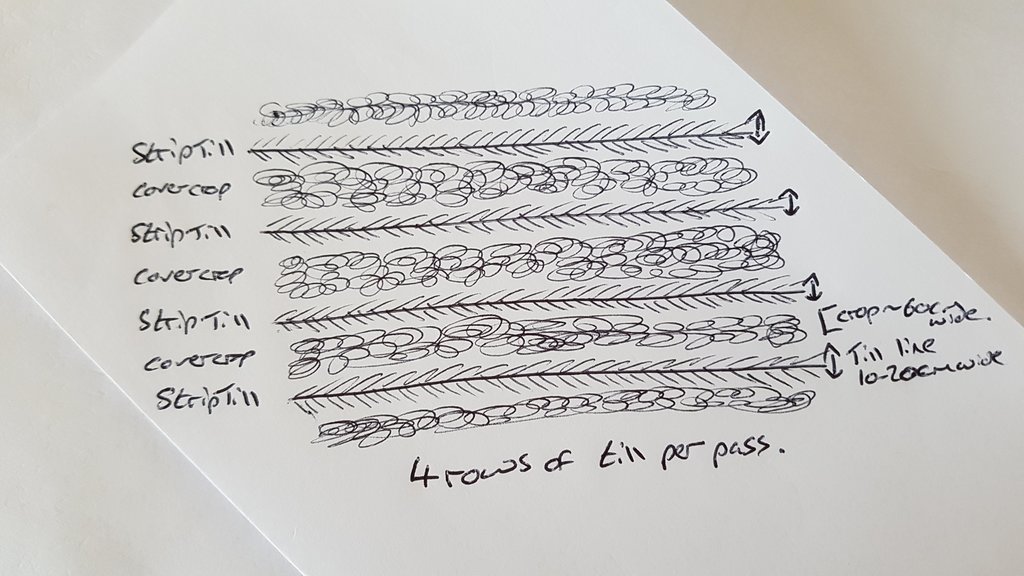Strip till to improve maize establishment [France]
- Creation:
- Update:
- Compiler: Alan Radbourne
- Editors: David Robinson, David Norris, Sabine Reinsch
- Reviewers: Rima Mekdaschi Studer, William Critchley
Strip till
technologies_5676 - France
View sections
Expand all Collapse all1. General information
1.2 Contact details of resource persons and institutions involved in the assessment and documentation of the Technology
Key resource person(s)
co-compiler:
Faure Marie-Line
Chamber of Agriculture of Pays de la Loire
France
land user:
Colineau Denis
Gaec Des Emeraudes
France
co-compiler:
Drouet Baptiste
Chamber of agriculture of Pays de la Loire
France
Name of project which facilitated the documentation/ evaluation of the Technology (if relevant)
European Interreg project FABulous FarmersName of the institution(s) which facilitated the documentation/ evaluation of the Technology (if relevant)
UK Centre for Ecology & Hydrology (CEH) - United KingdomName of the institution(s) which facilitated the documentation/ evaluation of the Technology (if relevant)
Association des Chambres d’agriculture de l’Arc Atlantique (AC3A) - France1.3 Conditions regarding the use of data documented through WOCAT
The compiler and key resource person(s) accept the conditions regarding the use of data documented through WOCAT:
Yes
1.4 Declaration on sustainability of the described Technology
Is the Technology described here problematic with regard to land degradation, so that it cannot be declared a sustainable land management technology?
No
2. Description of the SLM Technology
2.1 Short description of the Technology
Definition of the Technology:
Strip tillage to plant maize: a way to reduce soil disturbance and secure maize establishment.
2.2 Detailed description of the Technology
Description:
The region of Pays de Loire in Western France has a temperate climate with warm summers and mild winters. The region has many rural areas, dedicated mostly to agriculture, with large economic centres and conurbations (e.g. the Nantes area). The strip till technology is applied to te same area on a dairy farm in Pays de Loire (La Pouëze), which implements a form of conservation agriculture. Fields have not been ploughed for 9 years, and direct seeding of cover crops (i.e. clover seeded cover for green mulch, weed control and nitrogen fixation) and winter crops (economic cash crop) has been used for 4 years. Crop rotation is practiced on a 2 year rotation between spring maize and winter wheat.
Strip till is a conservation system that uses minimum tillage. It combines the soil drying and warming benefits of conventional tillage with the soil-protecting advantages of no-till by disturbing only the portion of the soil that is to be seeded. Strip till has been developed as an alternative to conventional tillage to prepare the soil before planting maize. It targets tillage on the line to be seeded: on 10 to 20 cm wide strips, at a depth of 10 to 30 cm. Strip till is harder to use in clayey and lumpy soil.
Strip till protects roots and facilitates crop establishment by creating higher soil porosity and seed line warming. As strip till does not disturb the inter-row, soil disturbance is minimized leading to:
-Improved production
-Reduced land degradation
-Beneficial economic impact
Initial investment costs are limited to purchasing the specialised strip till machine, which is about Euro 14,000. Benefits of strip till include:
- Increased: crop production, farm income, water drainage, nutrient cycling, soil organic matter carbon, vegetation cover, beneficial soil species, and habitat diversity
- Reduced: risk of production failure, workload/time, fuel, surface water runoff, evaporation, soil crusting, soil compaction, impact on soil life, and weed emergence
The compilation of this SLM is a part of the European Interreg project FABulous Farmers which aims to reduce the reliance on external inputs by encouraging the use of methods and interventions that increase the farm’s Functional AgroBiodiversity (FAB). Visit www.fabulousfarmers.eu and www.nweurope.eu/Fabulous-Farmers for more information.
2.3 Photos of the Technology
2.5 Country/ region/ locations where the Technology has been applied and which are covered by this assessment
Country:
France
Region/ State/ Province:
Pays de Loire
Further specification of location:
La Pouëze
Specify the spread of the Technology:
- evenly spread over an area
If the Technology is evenly spread over an area, specify area covered (in km2):
0.3
If precise area is not known, indicate approximate area covered:
- 0.1-1 km2
Is/are the technology site(s) located in a permanently protected area?
No
Map
×2.6 Date of implementation
Indicate year of implementation:
2015
2.7 Introduction of the Technology
Specify how the Technology was introduced:
- through projects/ external interventions
Comments (type of project, etc.):
Discussions in soil training sessions, trade fairs and farmers' groups
3. Classification of the SLM Technology
3.1 Main purpose(s) of the Technology
- improve production
- reduce, prevent, restore land degradation
- create beneficial economic impact
3.2 Current land use type(s) where the Technology is applied
Land use mixed within the same land unit:
No

Cropland
- Annual cropping
Annual cropping - Specify crops:
- cereals - maize
Number of growing seasons per year:
- 1
Is intercropping practiced?
Yes
If yes, specify which crops are intercropped:
Maize - Cover crops
Is crop rotation practiced?
Yes
If yes, specify:
Crop rotation is practiced on a 2 year rotation between spring Maize and winter Wheat
3.3 Has land use changed due to the implementation of the Technology?
Has land use changed due to the implementation of the Technology?
- No (Continue with question 3.4)
3.4 Water supply
Water supply for the land on which the Technology is applied:
- rainfed
3.5 SLM group to which the Technology belongs
- rotational systems (crop rotation, fallows, shifting cultivation)
- minimal soil disturbance
3.6 SLM measures comprising the Technology

agronomic measures
- A1: Vegetation/ soil cover
- A2: Organic matter/ soil fertility
- A3: Soil surface treatment
3.7 Main types of land degradation addressed by the Technology

soil erosion by water
- Wt: loss of topsoil/ surface erosion

chemical soil deterioration
- Cn: fertility decline and reduced organic matter content (not caused by erosion)

physical soil deterioration
- Pc: compaction

biological degradation
- Bl: loss of soil life
3.8 Prevention, reduction, or restoration of land degradation
Specify the goal of the Technology with regard to land degradation:
- reduce land degradation
4. Technical specifications, implementation activities, inputs, and costs
4.1 Technical drawing of the Technology
Technical specifications (related to technical drawing):
The strip till is a machine equipped with:
- 4 teeth permitting soil tillage at a soil depths between 10 cm and 30 cm
- 4 pairs discs to crumble the soil between 10 cm and 20 cm depth for preparation of the seedbed
Between each till line cover crops can be allowed to remain but may be cut back to near soil level to reduce competition with crop seeds.
Technology was applied on 30ha of maize plantation in regular row planting formation.
Author:
Alan Rabdourne
Date:
29/03/2021
4.2 General information regarding the calculation of inputs and costs
Specify how costs and inputs were calculated:
- per Technology area
Indicate size and area unit:
30 ha
If using a local area unit, indicate conversion factor to one hectare (e.g. 1 ha = 2.47 acres): 1 ha =:
1 ha = 2.47 acres
other/ national currency (specify):
€
If relevant, indicate exchange rate from USD to local currency (e.g. 1 USD = 79.9 Brazilian Real): 1 USD =:
0.9
Indicate average wage cost of hired labour per day:
120
4.3 Establishment activities
| Activity | Timing (season) | |
|---|---|---|
| 1. | Purchase of strip till plough | one-off purchase in 2015 |
| 2. | Cutting cover crop | pre-planting crop seed |
| 3. | Strip till and seeding | Crop planting |
4.4 Costs and inputs needed for establishment
| Specify input | Unit | Quantity | Costs per Unit | Total costs per input | % of costs borne by land users | |
|---|---|---|---|---|---|---|
| Labour | Cover crop cutting | day | 1.0 | 120.0 | 120.0 | 100.0 |
| Labour | Strip till & seeding | day | 1.5 | 120.0 | 180.0 | 100.0 |
| Equipment | Strip till | per till | 1.0 | 14000.0 | 14000.0 | 100.0 |
| Equipment | Tractor (inc fuel) | day | 2.5 | 50.0 | 125.0 | 100.0 |
| Total costs for establishment of the Technology | 14425.0 | |||||
| Total costs for establishment of the Technology in USD | 16027.78 | |||||
4.5 Maintenance/ recurrent activities
| Activity | Timing/ frequency | |
|---|---|---|
| 1. | Strip till run | Annual |
| 2. | Cover crop management | Annual |
4.6 Costs and inputs needed for maintenance/ recurrent activities (per year)
| Specify input | Unit | Quantity | Costs per Unit | Total costs per input | % of costs borne by land users | |
|---|---|---|---|---|---|---|
| Labour | Cutting cover crop | day | 1.0 | 120.0 | 120.0 | 100.0 |
| Labour | Strip till & seeding | day | 1.5 | 120.0 | 180.0 | 100.0 |
| Equipment | Strip till maintanance | per item | 1.0 | 100.0 | 100.0 | 100.0 |
| Equipment | Tractor (inc fuel) | day | 2.5 | 50.0 | 125.0 | 100.0 |
| Total costs for maintenance of the Technology | 525.0 | |||||
| Total costs for maintenance of the Technology in USD | 583.33 | |||||
4.7 Most important factors affecting the costs
Describe the most determinate factors affecting the costs:
The initial investment to buy the strip till is high, but its cost by passage is lower than ploughing or other simplified techniques of implantation.
5. Natural and human environment
5.1 Climate
Annual rainfall
- < 250 mm
- 251-500 mm
- 501-750 mm
- 751-1,000 mm
- 1,001-1,500 mm
- 1,501-2,000 mm
- 2,001-3,000 mm
- 3,001-4,000 mm
- > 4,000 mm
Specify average annual rainfall (if known), in mm:
650.00
Specifications/ comments on rainfall:
Mild and rainy winter, hot dry summers (lately)
Indicate the name of the reference meteorological station considered:
Beaucouzé meteorological station
Agro-climatic zone
- sub-humid
5.2 Topography
Slopes on average:
- flat (0-2%)
- gentle (3-5%)
- moderate (6-10%)
- rolling (11-15%)
- hilly (16-30%)
- steep (31-60%)
- very steep (>60%)
Landforms:
- plateau/plains
- ridges
- mountain slopes
- hill slopes
- footslopes
- valley floors
Altitudinal zone:
- 0-100 m a.s.l.
- 101-500 m a.s.l.
- 501-1,000 m a.s.l.
- 1,001-1,500 m a.s.l.
- 1,501-2,000 m a.s.l.
- 2,001-2,500 m a.s.l.
- 2,501-3,000 m a.s.l.
- 3,001-4,000 m a.s.l.
- > 4,000 m a.s.l.
Indicate if the Technology is specifically applied in:
- not relevant
5.3 Soils
Soil depth on average:
- very shallow (0-20 cm)
- shallow (21-50 cm)
- moderately deep (51-80 cm)
- deep (81-120 cm)
- very deep (> 120 cm)
Soil texture (topsoil):
- medium (loamy, silty)
Soil texture (> 20 cm below surface):
- medium (loamy, silty)
Topsoil organic matter:
- medium (1-3%)
5.4 Water availability and quality
Ground water table:
< 5 m
Availability of surface water:
medium
Water quality (untreated):
for agricultural use only (irrigation)
Water quality refers to:
both ground and surface water
Is water salinity a problem?
No
Is flooding of the area occurring?
No
5.5 Biodiversity
Species diversity:
- medium
Habitat diversity:
- medium
5.6 Characteristics of land users applying the Technology
Sedentary or nomadic:
- Sedentary
Market orientation of production system:
- commercial/ market
Off-farm income:
- 10-50% of all income
Relative level of wealth:
- rich
Individuals or groups:
- individual/ household
Level of mechanization:
- mechanized/ motorized
Gender:
- men
Age of land users:
- middle-aged
5.7 Average area of land used by land users applying the Technology
- < 0.5 ha
- 0.5-1 ha
- 1-2 ha
- 2-5 ha
- 5-15 ha
- 15-50 ha
- 50-100 ha
- 100-500 ha
- 500-1,000 ha
- 1,000-10,000 ha
- > 10,000 ha
Is this considered small-, medium- or large-scale (referring to local context)?
- medium-scale
5.8 Land ownership, land use rights, and water use rights
Land ownership:
- individual, titled
Land use rights:
- leased
Water use rights:
- individual
Are land use rights based on a traditional legal system?
No
5.9 Access to services and infrastructure
health:
- poor
- moderate
- good
education:
- poor
- moderate
- good
technical assistance:
- poor
- moderate
- good
employment (e.g. off-farm):
- poor
- moderate
- good
markets:
- poor
- moderate
- good
energy:
- poor
- moderate
- good
roads and transport:
- poor
- moderate
- good
drinking water and sanitation:
- poor
- moderate
- good
financial services:
- poor
- moderate
- good
6. Impacts and concluding statements
6.1 On-site impacts the Technology has shown
Socio-economic impacts
Production
crop production
Comments/ specify:
Efficiency increased in production due to benefit of quicker tillage and benefits of interseedin with cover crops.
risk of production failure
Comments/ specify:
No change in risk.
Income and costs
expenses on agricultural inputs
Comments/ specify:
Reduced tillage reduces costs
farm income
Comments/ specify:
Reduced costs leads to greater profit margin
workload
Comments/ specify:
Significant reduction in the frequency of tool changeover.
Ecological impacts
Water cycle/ runoff
surface runoff
Comments/ specify:
Due to reduced soil disturbance
excess water drainage
Comments/ specify:
Reduced passages across field, reduces compaction and improves soil water drainage.
evaporation
Comments/ specify:
reduced soil disturbance results in less evaporation
Soil
soil moisture
Comments/ specify:
No change
soil cover
Comments/ specify:
Reduced disturbance and compaction improves soil cover
soil loss
Comments/ specify:
Reduced soil disturbance limits soil loss
soil crusting/ sealing
Comments/ specify:
Persistance of cover srop and reduced soil disturbance reduces soil cursting potential
soil compaction
Comments/ specify:
Less passages across the field with less equipment use reduces compaction.
soil organic matter/ below ground C
Comments/ specify:
Reduced soil disturbance allows for improved organic matter development
Biodiversity: vegetation, animals
Vegetation cover
Comments/ specify:
Cover cropping persistence with inter-seeding in strips
biomass/ above ground C
Comments/ specify:
Cover cropping persistence with inter-seeding in strips
beneficial species
Comments/ specify:
Cover cropping mix encourages increased beneficial species
habitat diversity
Comments/ specify:
Cover cropping mix encourages increased habitat diversity
6.3 Exposure and sensitivity of the Technology to gradual climate change and climate-related extremes/ disasters (as perceived by land users)
Gradual climate change
Gradual climate change
| Season | increase or decrease | How does the Technology cope with it? | |
|---|---|---|---|
| annual temperature | increase | well | |
| annual rainfall | decrease | very well |
6.4 Cost-benefit analysis
How do the benefits compare with the establishment costs (from land users’ perspective)?
Short-term returns:
very positive
Long-term returns:
positive
How do the benefits compare with the maintenance/ recurrent costs (from land users' perspective)?
Short-term returns:
very positive
Long-term returns:
positive
6.5 Adoption of the Technology
- single cases/ experimental
Of all those who have adopted the Technology, how many did so spontaneously, i.e. without receiving any material incentives/ payments?
- 0-10%
6.6 Adaptation
Has the Technology been modified recently to adapt to changing conditions?
No
6.7 Strengths/ advantages/ opportunities of the Technology
| Strengths/ advantages/ opportunities in the land user’s view |
|---|
| Reduced soil compaction for maize implantation |
| Reduced drying of the soil that reduces the negative impact on soil biology |
| Makes it possible to locate fertilizer inputs |
| Strengths/ advantages/ opportunities in the compiler’s or other key resource person’s view |
|---|
| Reduced soil compaction |
| Reduced drying of the soil |
| Improved soil health and stability |
6.8 Weaknesses/ disadvantages/ risks of the Technology and ways of overcoming them
| Weaknesses/ disadvantages/ risks in the land user’s view | How can they be overcome? |
|---|---|
| Challenging in a lumpy or clayey soil | Take longer to process and implement |
| Complexity of tool settings | The settings are the same once selected |
| Weaknesses/ disadvantages/ risks in the compiler’s or other key resource person’s view | How can they be overcome? |
|---|---|
| Challenging in a lumpy or clayey soil | Take longer to process and implement |
7. References and links
7.1 Methods/ sources of information
- field visits, field surveys
1 farm example
- interviews with land users
1 land user
- interviews with SLM specialists/ experts
1 SLM specialist
When were the data compiled (in the field)?
12/11/2019
Links and modules
Expand all Collapse allLinks
No links
Modules
No modules


